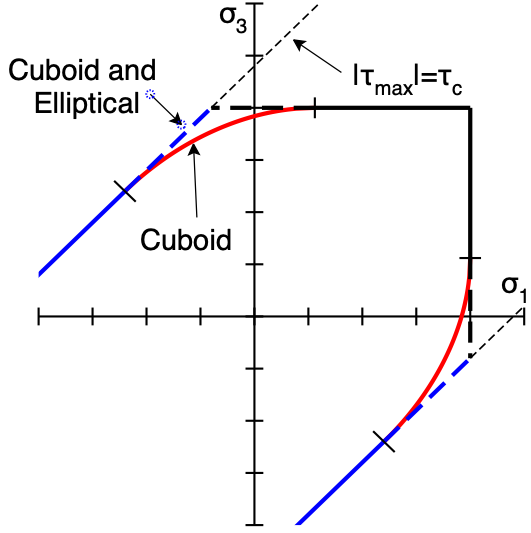Difference between revisions of "Isotropic Material Failure Surface"
| Line 9: | Line 9: | ||
Maximum principle failure stress surfaces for 2D and 3D simulations are shown in the figure. When viewed down the <math>\sigma_1=\sigma_2=\sigma_3</math> diagonal, the 3D surface is hexagonal rod with point-to-point diagonal equal to <math>\tau_t</math> and apex at <math>\sigma_1=\sigma_2=\sigma_3=\sigma_n</math>. For tensile failure, the crack normal is along the maximum principle stress direction; for shear failure, it is rotated 45 degrees from the principle stress directions. | Maximum principle failure stress surfaces for 2D and 3D simulations are shown in the figure. When viewed down the <math>\sigma_1=\sigma_2=\sigma_3</math> diagonal, the 3D surface is hexagonal rod with point-to-point diagonal equal to <math>\tau_t</math> and apex at <math>\sigma_1=\sigma_2=\sigma_3=\sigma_n</math>. For tensile failure, the crack normal is along the maximum principle stress direction; for shear failure, it is rotated 45 degrees from the principle stress directions. | ||
Note this failure criterion never fails under hydrostatic compression. Compression failure only occurs if the principle stress point moves far enough from the diagonal to reach the shear failure surface. The failure process is by shear. | |||
== Damage Law Properties == | == Damage Law Properties == | ||
| Line 22: | Line 24: | ||
| tauc ||Critical shear stress for failure || [[ConsistentUnits Command#Legacy and Consistent Units|pressure units]] || infinite | | tauc ||Critical shear stress for failure || [[ConsistentUnits Command#Legacy and Consistent Units|pressure units]] || infinite | ||
|} | |} | ||
Revision as of 13:32, 25 December 2016
Introduction
This damage initiation law predict that failure initiates when maximum principal stress exceeds tensile strength of the material or when maximum shear stress exceeds shear strength of the material. Because it deals with principal stresses and tensile failure is the same regardless of direction, this law is only appropriate for isotropic materials such as IsoSoftening material.
Failure Surface
Maximum principle failure stress surfaces for 2D and 3D simulations are shown in the figure. When viewed down the [math]\displaystyle{ \sigma_1=\sigma_2=\sigma_3 }[/math] diagonal, the 3D surface is hexagonal rod with point-to-point diagonal equal to [math]\displaystyle{ \tau_t }[/math] and apex at [math]\displaystyle{ \sigma_1=\sigma_2=\sigma_3=\sigma_n }[/math]. For tensile failure, the crack normal is along the maximum principle stress direction; for shear failure, it is rotated 45 degrees from the principle stress directions.
Note this failure criterion never fails under hydrostatic compression. Compression failure only occurs if the principle stress point moves far enough from the diagonal to reach the shear failure surface. The failure process is by shear.
Damage Law Properties
The following table lists the input properties for maximum principle stress failure surface:
| Property | Description | Units | Default |
|---|---|---|---|
| sigmac | Critical tensile stress for failure | pressure units | infinite |
| tauc | Critical shear stress for failure | pressure units | infinite |
